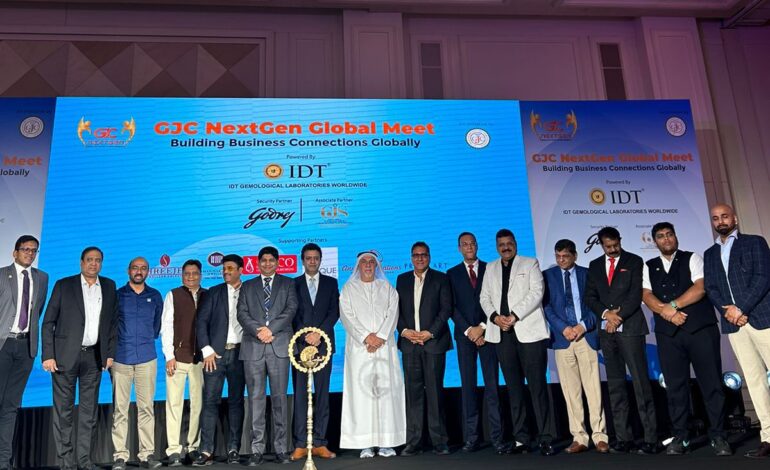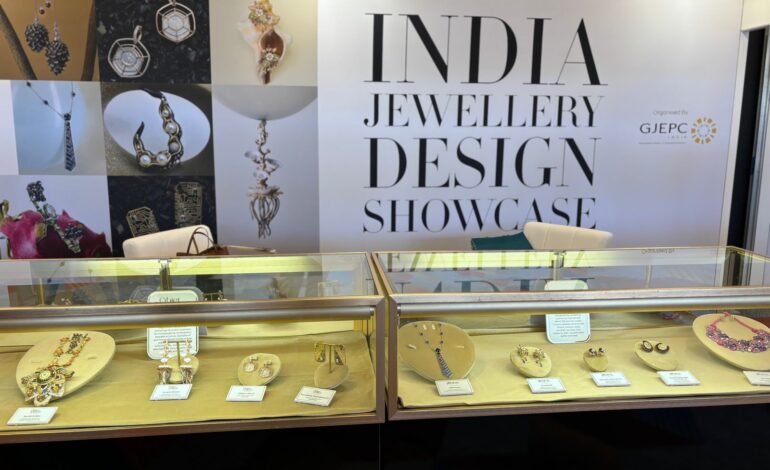GJC’s Gems and Jewellery Banking Summit calls for aggressive financing support for the sector’s growth
- By Jewel News Desk
- June 1, 2024

All India Gem & Jewellery Domestic Council (GJC) organised first of its kind one-day Gems and Jewellery Banking Summit presented by the World Gold Council presented at Jio World Convention Centre, Bandra Kurla Complex, Mumbai, on the 18th May 2024. The Summit was attended by leading Indian government and private bankers engaged directly or indirectly in the gold financing business. The Summit was powered by Yes Bank, Shree Kunj, Kolkata, and supported by Bangalore Refinery, Mukti Gold and Diamond, and Laxmi Diamonds India Ltd.
More than 200 delegates participated in the summit, with experts discussing the financing needs of the industry for a comprehensive growth of the entire value chain from bullion dealers to karigars, craftsman, manufacturers, wholesalers, and retailers. Speakers also deliberated about the risk management facilities available for Indian jewellers, and challenges being faced by the industry for future growth.
The Summit Consisted of Four Panels:
The 1st-panel discussion: Strength of the G&J Industry: Financing Opportunities for Bankers & Building Financial Resilience in the Gems & Jewellery Industry
Members of the panel were Mr. Saiyam Mehra, Chairman, GJC; Mr. Suvankar Sen, MD & CEO, Senco Gold & Diamond; Mr. Sachin Jain, Regional CEO, WGC – India; Mr. Ravi Prakash Agarwal, Director, GJC & Convener, Gems & Jewellery Banking Summit; Mr. Kumar Parmani, Senior President, Yes Bank; Mr. Manish Goel, Head Bullion, ICICI; moderated by Ms Manisha Gupta, Commodity Editor, CNBC Awaaz
The 2nd panel discussion: Understanding the Financial Tools of the Jewellery Industry
The panel consisted of Mr Rajesh Rokde, Vice Chairman, GJC; Mr BA Ramesh, Joint Managing Director, Thangamayil Jewellery Ltd.; Mr Ashok Minawala, Past Chairman, GJC; Mr Kuldeep Jindal, GM, Bank of India; Mr Johnson Lewis, MD, FinMet Pte. Ltd.; moderated by Mr Sahil Mehra, Director, GJC
The 3rd-panel discussion: Banking Strategy to Revitalizing and Empower
“The esteemed panellists were Mr Ashish Pethe, Immediate Past Chairman, GJC; Mr Nitin Khandelwal, Past Chairman, GJC; Mr Kinjal Shah, Head of Asian Development, Responsible Jewellery Council; Mr Neville Patel, SVP, HDFC; Mr Prabu K.K., Chief Manager, Karur Vysya Bank; Mr Chirag Sheth, Principal Consultant, Metals Focus, South Asia; and moderated by Mr Mrituenjay Kumar Jha, Commodity Editor, Zee Business
The 4th-panel discussion: Risk Management Mechanisms
The panel, consisting of industry leaders Mr Avinash Gupta, Owner & Partner, Mamraj Mussadilal Jewellers; Mr Manish Gavaskar, Vice President – Bullion Sales & Analytics, RBL Bank; Mr Mehul Thakker, Business Head, FirstRand Bank; and Mr Himank Sharma, Director – Mid Corporates Group, CRISIL Ratings Ltd., was expertly moderated by Mr Bijayananda Pattanayak, EVP & Head – Gems & Jewellery, IndusInd Bank
Recognising its potential for growth and value addition, the government has declared the gems and jewellery sector as focussed area and introduced two suitable policies: Hallmarking for Accuracy Determination, and the Gold Monetization Scheme (GMS), which enables individuals to deposit gold with banks and earn interest.
Mr Saiyam Mehra, Chairman of All India Gem & Jewellery Domestic Council, stated, “The industry is facing challenges such as higher interest rates on business loans, lack of transparency on banking policy, and limited access to bank loans. Infusion of more funds into the gems and jewellery industry has become a matter of prime concern as banks have categorized this sector as high risk, leading to a drop in loan take-offs. The government has implemented measures to encourage investment strategy, and promoted Brand India in the global market.”
The Indian jewellery industry stands on the threshold of compounded growth which will be driven by factors such as rising disposable income, increasing urbanization, growing financial consciousness, rising demand for branded and customized products, and favourable government policies. However, the industry is constrained the credit availability for the gem and jewellery industry.
Experts believe that due to the perceived lack of transparency, bankers are reluctant to finance gems and jewellery businesses to a large extent. Access to finance remains a cornerstone for the growth of any industry, and the gems and jewellery sector is no exception. It is incumbent upon valued bankers to design tailored financial products and services that meet the unique needs of the industry stakeholders, from artisans, craftsman to a large-scale exporter. The government has allowed 100 foreign direct investment (FDI) through the automatic route to achieve a US$ 100 billion industry by 2027.
Rajesh Rokde, Vice Chairman of GJC said, “We have more than 3000 jewellers as our members, 250 jewellery associations, and more than 65,000 partners engaged with us directly or indirectly. GJC works for the betterment not only for manufacturers but also for karigars, wholesalers and retailers. This means GJC is working 360 degrees for the entire jewellery value chain from bullion dealers to retailers. We have recently introduced the ‘Lucky Luxmi’ scheme to accelerate sales and enhance jewellery trade. Our responsibility does not end with organizing exhibitions only but we work for the progress of the entire jewellery sector. Today’s banking summit is a part of that.
Mr Ravi Prakash Agarwal, Convenor of the Bank Summit, informed, “We are delighted that the who’s who in the banking sector have recognised the challenges being faced by jewellers, and enormous opportunity available for bankers for lending to this sector. With NPA having less than 1%, we urge bankers to extend funding aggressively for both entrepreneurs and existing businesses.”
Jewellers called upon bankers to share information with the gems and jewellery industry as the lack of accurate industry data hinders the growth of the industry. Therefore, it is crucial to address the dissemination of information, and banks are urged to support in providing information to the gems and jewellery sector as many of them fall under the category of micro, small, and medium enterprises (MSMEs). Also, jewellers requested bankers to avail finances at an interest rate similar to that of other industries at 8-9%, with a risk spread of 1%. Additionally, the industry sought easier policies and facilitation for EMI-based buying facilities for end consumers. Credit card swiping and POS machine implementation are needed in every retail showroom.
Moreover, leveraging the power of technology to drive efficiency, transparency, and resilience across the value chain. Whether the doctrine of AI for predictive analysis or harnessing fintech solutions for supply chain finance, the opportunities are boundless. The banking sector has an immense opportunity as the jewellery retail market is experiencing immense growth. We are looking to more than 3000 retail showrooms opening in the next 18 months. The organised retail market held between 32-35% of the market share in 2022, with market size of Rs 150,000-160,000 crore, and expecting to become 40% by 2024. The domestic industry has a unique benefit for preparing KYC for creating a database for more transparency in this sector.
Disclaimer: Jewel Bharat aims to provide accurate and reliable information. Readers are encouraged to contact@jewelbharat.com to report any concerns regarding the content. Appropriate corrective measures, including potential removal of the article from the website, will be taken following investigation.




